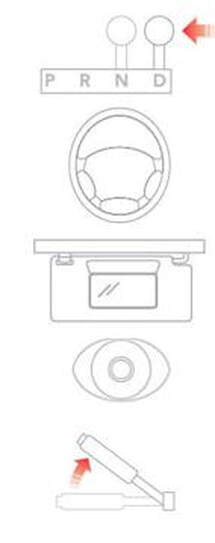Vehicle Control for Supervisors
Teaching a new driver can be stressful, but knowing you have some control can help. Professional driver’s education instructors are taught emergency responses to potential hazards that can crop up with an inexperienced driver behind the wheel. Here are some skills you can learn to help you maintain control from the passenger seat while teaching:
|
Emergency Shifting: In a quiet, large, level, empty area, practice shifting the transmission from drive to neutral. Taking the wheel: With an experienced driver in the driver seat, in a quiet, large, level empty area, practice steering the car with your left hand from the passenger seat. Mirrors: Adjust the mirror on the passenger sun visor so you can use it as a rearview mirror. If the right side mirror is properly adjusted, you can use it to monitor traffic to the rear from the passenger seat Awareness: Never assume everything is okay. Always check and re-check mirrors before you give instructions to your teen. Emergency stopping: Practice stopping the car with the parking brake (if your vehicle’s parking brake is located between the seats). This can be dangerous, even at low speeds, and should only be used as a last resort. Remember to keep the button depressed as you pull up on the brake. This will allow you to control the amount of pressure on the brakes. If you pull up without holding the button, the rear wheels will lock up and possibly induce a rear wheel skid. |
Driving Has Changed
Chances are today’s cars are not the same as they were when you learned to drive? To teach your teen effectively, you need to know about a few important recent changes in how cars work, how we drive, and how driving is taught. Teach your new driver to not rely on the advanced systems your car may be equipped with (i.e. automatic braking, blind spot monitoring, collision warning, etc.…).
Anti-lock Brake System (ABS): Most new cars offer ABS as standard equipment. ABS is a dramatic safety improvement that works by letting the tires rotate, rather than lock up, when the brake is engaged. This allows drivers to turn the car during an emergency stop. ABS should be used with firm, continuous pressure. The brakes may shake and grind when applied, which often concerns users – but this is a normal function of ABS. To find out if your car has ABS, check the instrument panel after you turn on the ignition or read the owner’s manual. (see Common Instrument Panel Lights section for what this symbol looks like.)
Note: When driving a car without ABS, the old rules still apply. Don’t “slam” the brakes. Rather, press the brake pedal firmly. The intention is to stop quickly, but also to avoid locking the brakes and skidding. Skidding causes a loss of control and requires more distance to stop.
Commentary driving: Commentary driving is a great communication tool. Coach your teen to describe their actions, thoughts and observations out loud as they drive, similar to a sports commentator. Throughout the learning process, ask them to verbalize what they see around them, including potential risks and any steps they need to take to avoid
Chances are today’s cars are not the same as they were when you learned to drive? To teach your teen effectively, you need to know about a few important recent changes in how cars work, how we drive, and how driving is taught. Teach your new driver to not rely on the advanced systems your car may be equipped with (i.e. automatic braking, blind spot monitoring, collision warning, etc.…).
Anti-lock Brake System (ABS): Most new cars offer ABS as standard equipment. ABS is a dramatic safety improvement that works by letting the tires rotate, rather than lock up, when the brake is engaged. This allows drivers to turn the car during an emergency stop. ABS should be used with firm, continuous pressure. The brakes may shake and grind when applied, which often concerns users – but this is a normal function of ABS. To find out if your car has ABS, check the instrument panel after you turn on the ignition or read the owner’s manual. (see Common Instrument Panel Lights section for what this symbol looks like.)
Note: When driving a car without ABS, the old rules still apply. Don’t “slam” the brakes. Rather, press the brake pedal firmly. The intention is to stop quickly, but also to avoid locking the brakes and skidding. Skidding causes a loss of control and requires more distance to stop.
Commentary driving: Commentary driving is a great communication tool. Coach your teen to describe their actions, thoughts and observations out loud as they drive, similar to a sports commentator. Throughout the learning process, ask them to verbalize what they see around them, including potential risks and any steps they need to take to avoid

